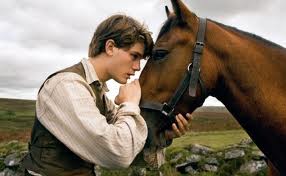He stood fearless and proud in readinessfor the battle ahead.
He had already braved four years ofwarfare, including the battle of the Somme in 1916.
 |
| Canadian cavalry charge: they were led by Warrior |
He had also survived the muddy hell ofPasschendaele.
Now, on 30 March, 1918, Warrior was to facehis toughest assignment. This 20-year-old chestnut-brown gelding was to leadone of the last great cavalry charges in history.
 |
| Warrior, with General Seely |
His mission was to stop the German SpringOffensive of 1918 and his adventures were to prove every bit as extraordinaryas those of Michael Morpurgo’s fictional warhorse.
Warrior was one of the million horses sentto France between 1914 and 1918. Only 62,000 of these ever returned home.
They are forgotten victims of a conflictthat pitted defenceless horses again tanks and machine guns.
Warrior belonged to General John Seely andboth were born survivors. Legend has it that when Seely recommended Warrior forthe Victoria Cross, his reasoning was simple: ‘He went everywhere I did.’
 |
| Great War: deadly for horses |
Warrior had certainly proved his mettle infour years of bloody conflict on the western front. He had arrived in France inthe summer of 1914: that autumn, he narrowly escaped capture by the advancingGerman army.
In the following year, the horse next tohim was killed when a shell ripped him in two. A few days later, Warrior’sstable was destroyed just seconds after he’d left it.
His most desperate moment had come atPasschendaele, where he was dug out of mud that was several feet deep.
In February, 1915, Warrior and Seely hadbeen put in command of the Canadian Cavalry, a rag-bag force of ranchers,Mounties and Native Americans.
 |
| Gas kills horses, too |
They numbered 1,000 horses and, in 1918,they were given a vital mission to accomplish. The German war machine hadripped through the British lines, taking more than 100,000 prisoners - men ofthe British Fifth Army. The Germans were making rapid progress westwards.
It was crucial that they should be checkedand the place chosen to halt their advance was at Moreuil Wood on the banks ofthe Avre River. Victory here would not only secure the river. It would alsostop the German thrust westwards.
The charge into the woodland was to takeplace on 30 March: it was to be led by Warrior and eleven other horses. Theirinitial task was to plant a red pennant on the hill above the river. This wouldact as a guide for the rest of the cavalry.
 |
| Warrior had already survived Passchendaele |
‘[Warrior] wasdetermined to go forward,’ wrote Seely, ‘and with a great leap started off. Allsensation of fear had vanished from him as he galloped on at racing speed.There was a hail of bullets from the enemy as we crossed the intervening spaceand mounted the hill, but Warrior cared for nothing.’
Warrior made it tothe hilltop and the pennant was planted. Seconds later, there was a loudthundering as 1,000 other horses followed him into battle.
Squadron aftersquadron rode into the chaos. Shells rained down on them and gunfire came fromevery angle.
Warrior and hisfellow horses were supported by the Royal Flying Corps which fired more than17,000 rounds. But it was to no avail: hundreds of horses were mown down byGerman machine gun fire.
 |
| Warrior meets the queen |
The battle continuedinto the late afternoon. Rain tipped from the metal-grey sky and the lightbegan to fade. Warrior continued to lead from the front until the battle slowlybegan to turn.
By nightfall, thewood had been taken and the German advance finally brought to a halt. Butvictory came at a heavy price. A quarter of the men - and more than half thehorses - had been killed in the slaughter.
There was no respitefor Warrior. He was to be called back into action on the following day in orderto lead an attack close to the village of Gentelles.
 |
| The fictional war horse: but don't forget Warrior |
But he was injured inthe dark and forced out of action. General Seely, too, was wounded and unableto continue.
Warrior’s escape fromdeath on so many occasions was truly remarkable. He lived until 1941, too oldto re-enter service in the Second World War.
Besides, warfare hadchanged beyond all recognition in the intervening years. There was no longer aplace for warhorses like Warrior to lead cavalry charges.
He remains one of theunsung heroes of the Great War - a faithful, devoted and extraordinarilycourageous warhorse who helped to secure victory on the Western Front.
Wolfram: The Boy Who Went to War available here for just £5.30
And for my American readers, it is now published under the title: The Boy Who Went to War: The Story of a Reluctant German Soldier in WWII available here










